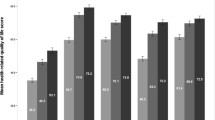Abstract
Background
Quality of life (QOL) is compromised among individuals with multiple sclerosis (MS). Self-efficacy and physical activity have been positively associated with QOL in persons with MS, and based on a social cognitive perspective, the relationship between physical activity and QOL might be indirect and accounted for by self-efficacy.
Purpose
We tested the hypothesis that physical activity would be indirectly associated with QOL through a pathway that included self-efficacy.
Methods
Participants were 133 individuals with a definite diagnosis of MS who completed the Godin Leisure-Time Exercise Questionnaire, Multiple Sclerosis Self-Efficacy scale, and Multiple Sclerosis Impact Scale.
Results
Path analysis indicated that those with MS who were more physically active had greater self-efficacy for function and control, and self-efficacy for function and control were associated with greater physical and psychological components of QOL.
Conclusions
Our findings support physical activity as a possible modifiable behavior for mitigating reductions of QOL by improving self-efficacy in individuals with MS.

Similar content being viewed by others
References
National Multiple Sclerosis Society. Multiple Sclerosis Information Sourcebook. New York, NY: Information Resource Center and Library of the National Multiple Sclerosis Society; 2005.
Benito-Leon J, Morales JM, Rivera-Navarro J, Mitchell AJ. A review about the impact of multiple sclerosis on health-related quality of life. Disabil Rehabil. 2003; 25: 1291–1303.
Miltenburger C, Kobelt G. Quality of life and cost of multiple sclerosis. Clin Neurol Neurosur. 2002; 104: 272–275.
Mitchell AJ, Benito-Leon J, Gonzalez JMM, Rivera-Navarro J. Quality of life and its assessment in multiple sclerosis: Integrating physical and psychological components of well-being. Lancet Neurol. 2005; 4: 556–566.
Bandura A. Self-Efficacy: The Exercise of Control. New York, NY: Freeman; 1997.
Schwartz CE, Coulthard-Morris L, Zeng Q, Retzlaff P. Measuring self-efficacy in people with multiple sclerosis: A validation study. Arch Phys Med Rehabil. 1996; 77: 394–398.
Riazi A, Thompson AJ, Hobart JC. Self-efficacy predicts self-reported health status in multiple sclerosis. Multiple Sclerosis. 2004; 10: 61–66.
Heesen C, Romberg A, Gold S, Schulz KH. Physical exercise in multiple sclerosis: Supportive care or a putative disease-modifying treatment. Expert Rev Neurotherapeutics. 2006; 63: 47–355.
Sutherland G, Andersen MB. Exercise and multiple sclerosis: Physiological, psychological, and quality of life issues. J Sports Med Phys Fitness. 2001; 41: 421–432.
Mostert S, Kesselring J. Effects of a short-term exercise training program on aerobic fitness, fatigue, health perception and activity level of subjects with multiple sclerosis. Mult Scler. 2002; 8: 161–168.
Oken BS, Kishiyama S, Zajdel D, et al. Randomized controlled trial of yoga and exercise in multiple sclerosis. Neurology. 2004; 62: 2058–2064.
McAuley E, Blissmer B. Self-efficacy determinants and consequences of physical activity. Exerc Sport Sci Rev. 2000; 28: 85–88.
Rejeski WJ, Mihalko SL. Physical activity and quality of life in older adults. J Gerontol Ser A Biol Sci Med Sci. 2001; 56: 23–35.
McAuley E, Konopack JF, MotlR W et al. Physical activity and quality of life in older adults: Influence of health status and self-efficacy. Annals Behav Med. 2006; 31: 99–103.
Godin G, Shephard RJ. A simple method to assess exercise behavior in the community. Can J App Sport Sci. 1985; 10: 141–146.
Gosney JL, Scott JA, Snook EM, Motl RW. Physical activity and multiple sclerosis: Validity of self-report and objective measures. Fam Community Health. 2007; 30: 144–150.
Motl RW, McAuley E, Snook EM, Scott JA. Validity of physical activity measures in ambulatory individuals with multiple sclerosis. Disabil Rehabil. 2006; 28: 1151–1156.
Hobart J, Lamping D, Fitzpatrick R, et al. The Multiple Sclerosis Impact Scale (MSIS-29): A new patient-based outcome measure. Brain. 2001; 124: 962–973.
Riazi A. Patient-reported outcome measures in multiple sclerosis. Int J MS Care. 2006; 13: 92–99.
Riazi A, Hobart JC, Lamping DL, et al. Multiple Sclerosis Impact Scale (MSIS-29): Reliability and validity in hospital based samples. J Neurol Neurosurg Psychiatry. 2002; 73: 701–704.
Muthén LK, Muthén BO. Mplus: The Comprehensive Modeling Program for Applied Researchers User’s Guide. Los Angeles, CA Muthén and Muthén; 1998.
Enders CK, Bandalos DL. The relative performance of full information maximum likelihood estimation for missing data in structural equation models. Struct Equ Modeling. 2001; 8: 430–457.
Bollen KA. Structural Equations with Latent Variables New York, NY: Wiley; 1989.
Hu L, Bentler PM. Cutoff criteria for fit indices in covariance structure analysis: Conventional criteria versus new alternatives. Struct Equ Modeling. 1999; 6: 1–55.
Courneya KS, Friedenreich CM. Physical exercise and quality of life following cancer diagnosis: A literature review. Annals Behav Med. 1999; 21: 171–179.
McAuley E, Elavsky S. Physical activity, aging, and quality of life: Implications for measurement. In Zhu W, Measurement Issues and Challenges in Aging Research. Champaign, IL: Human Kinetics, 2005; 57–68.
Weinstein ND. Misleading tests of health behavior theories. Annals of Behav Med. 2007; 33: 1–10.
Author information
Authors and Affiliations
Corresponding author
About this article
Cite this article
Motl, R.W., Snook, E.M. Physical Activity, Self-Efficacy, and Quality of Life in Multiple Sclerosis. ann. behav. med. 35, 111–115 (2008). https://doi.org/10.1007/s12160-007-9006-7
Received:
Published:
Issue Date:
DOI: https://doi.org/10.1007/s12160-007-9006-7




